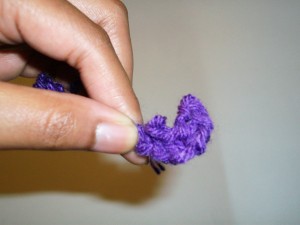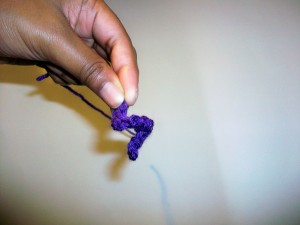Another Take on Crocheted Twirls
By Candace – 6 CommentsHave you ever worked on a spiral scarf and suddenly realized that your 50 stitches has bloomed to 400 and felt like the row would never end? It can be tiring to plod along the row, especially if the scarf has a plain stitch. If you work backwards and start with a long chain whose stitches disappear by half each row, it can feel like you’re going faster even though in the end, you have the same number of stitches.
Decreasing creates twirls just like increasing does. The shorter rows are the center, and the longer rows make up the outside of the twirl. In this picture, you can see the the fabric starting to curl after having a few decreases worked into it.

Tips for twirls:
Work with multiples of different numbers and experiment with the way the twirls pull in. Try a multiple of three and dc3tog across the row or use a multiple of four and dc4tog across the row.
Keep in mind the number of stitches you plan to have in the last row and take the curl into account for the length of your twirls. A longer starting chain doesn’t necessarily mean a longer project when it’s finished.
When deciding which method to use, take into account what would bother you more: having to make a long chain to start or having to multiply your stitches in every row.

Having fun experimenting! If you need any help with your twirls, feel free to leave a comment below.


Thanks, Candace! This was fascinating; I haven’t actually worked a spiral, but just thinking about the math and about the uses for increases and decreases was both educational and fun!
That’s brilliant! Great advice, thanks :).
hey i have been trying to find a pattern for the twirl my friends daughter has some that somebody made her a long time ago. what i am needing to know is how many do you chain to get started and how and what stitch do you use. i see that you said that**** Work with multiples of different numbers and experiment with the way the twirls pull in. Try a multiple of three and dc3tog across the row or use a multiple of four and dc4tog across the row.
Keep in mind the number of stitches you plan to have in the last row and take the curl into account for the length of your twirls. A longer starting chain doesn’t necessarily mean a longer project when it’s finished.
When deciding which method to use, take into account what would bother you more: having to make a long chain to start or having to multiply your stitches in every row.
how many chains and what stitch is multiple of three and then you would dc3tog (which is 3 in the same spot) please let me know thank you norma
Norma, I can’t adequately answer your question because I do not know exactly what you want. What you’ll need to do is determined by the actual dimensions you want, the yarn you wish to use, and your personal gauge. The number and type of stitches you use will revolve around that. My suggestion is that you work out these factors first and then revisit this tutorial and/or http://www.crochetspot.com/3-ways-to-use-crocheted-twirls/ .
@Candace – What a great idea! You’re absolutely right about the feeling of a never-ending project when making twirls. This reverse twirling strategy will work a treat on reversing our psychology and make crochet twirling much more fun.
LOL, as I sit on the final row of my swirl scarf, loathe to pick it up again, this would have been the better option for me!